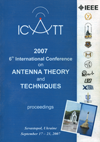Influence of thickness of perfectly conducting plate on its scattering characteristics
DOI:
https://doi.org/10.1109/ICATT.2007.4425164Keywords:
finite-difference time-domain method, conducting plate, integral equation method, scattering diagramAbstract
Scattering characteristics of perfectly conducting rectangular flat plate are analyzed for frequency region near resonance. The finite-difference time-domain method is used in simple and efficient form. Scattering diagram and radar cross-section are examined. The method is tested by integral equation method first and foremost.References
YEE, K.S. Numerical solution of initial boundary value problems involving Maxwell's equations in isotropic media. IEEE Trans. Antennas Propag., May 1966, v.14, n.3, p.302-307, doi: http://dx.doi.org/10.1109/TAP.1966.1138693.
MITTRA, R. (ed.). Computer Techniques for Electromagnetics. Oxford-New York-Toronto-Sydney-Braunschweig: Pergamon Press, 1973, 485 p.
KOUYOUMJIAN, R.G. The calculation of the echo areas of perfectly conduction objects by variational method. Ph.D. dissertation, Dept. of Elec. Engrg., The Ohio State University, Columbus, Dec. 1953.
MUR, G. Absorbing boundary conditions for the finite-difference approximation of the time-domain electromagnetic-field equations. IEEE Trans. Electromagnetic Compatibility, Nov. 1981, v.EMC-23, n.4, p.377-382, doi: http://dx.doi.org/10.1109/TEMC.1981.303970.
MEREWETHER, D.E.; FISHER, R.; SMITH, F.W. On implementing a numeric Huygen's source scheme in a finite difference program to illuminate scattering bodies. IEEE Trans. Nuclear Science, Dec. 1980, v.27, n.6, p.1819-1833, doi: http://dx.doi.org/10.1109/TNS.1980.4331114.

